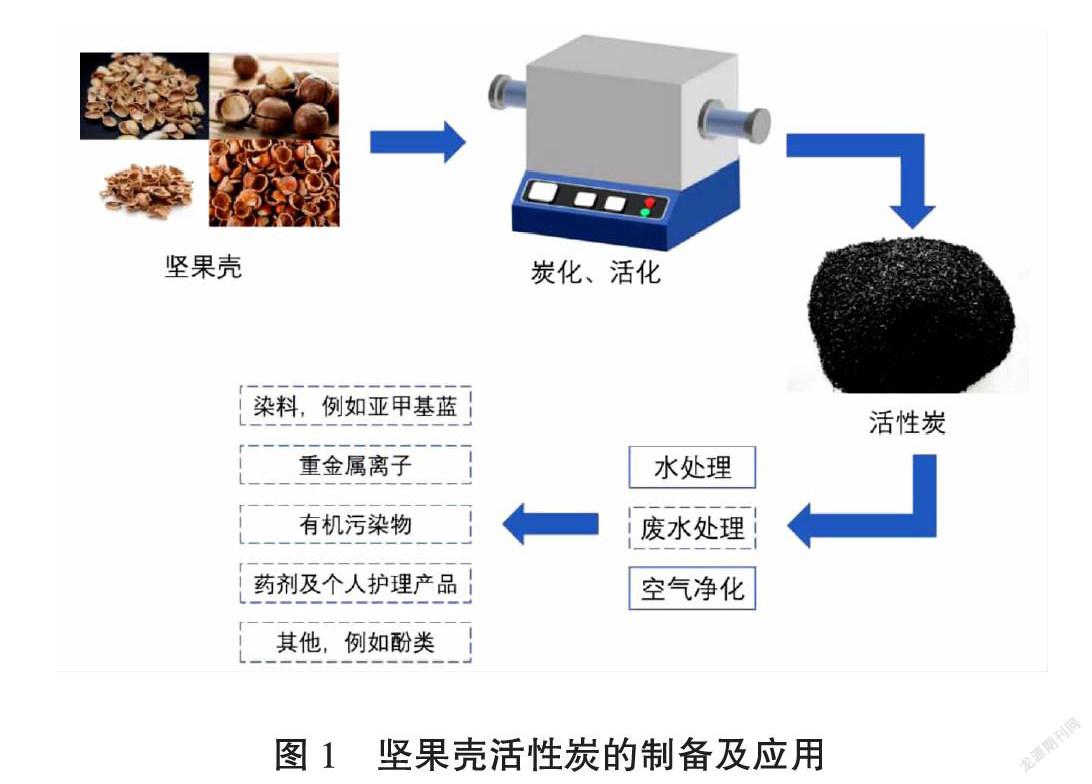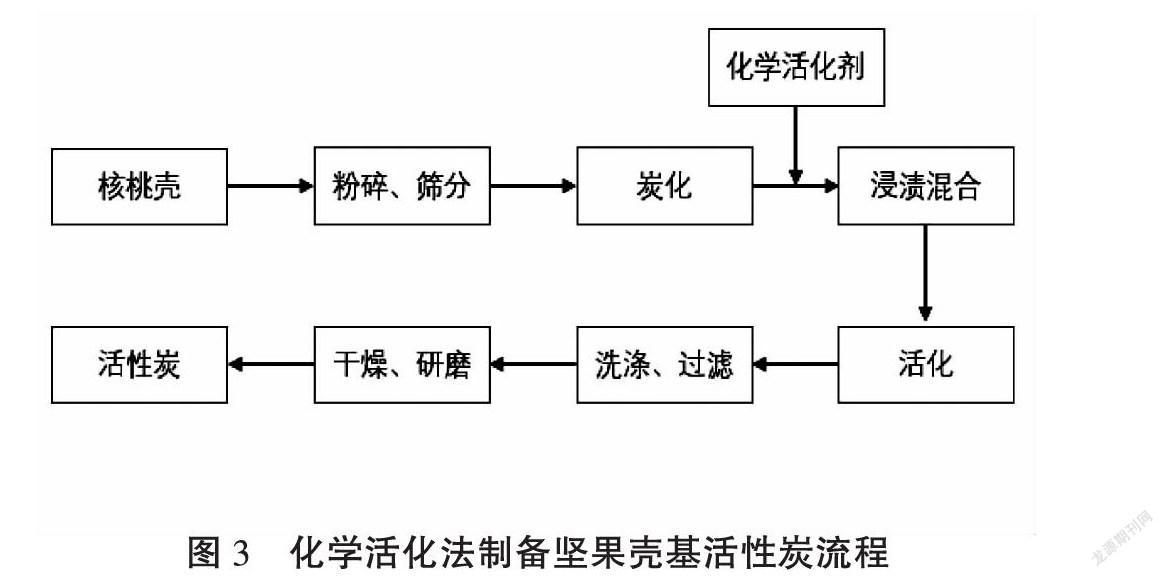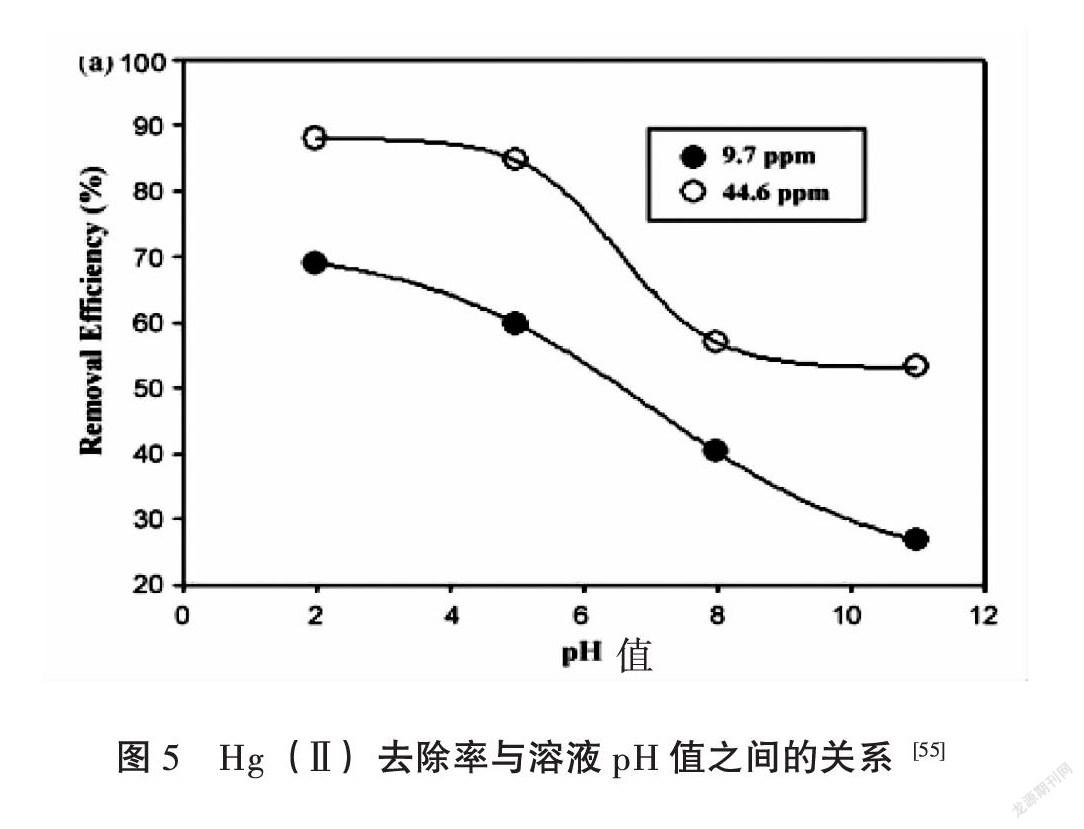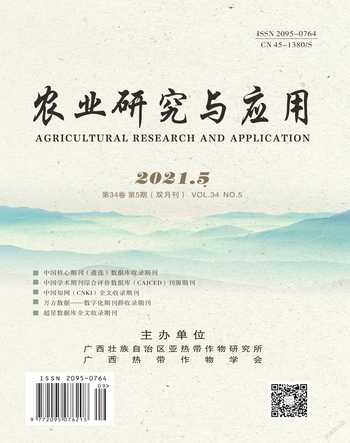坚果壳基活性炭制备及其在废水处理中应用的研究进展
王文林 宋海云 刘灿 谭秋锦 黄锡云 贺鹏 张涛 施蕊 王文栋









摘 要:活性炭吸附技术是减少污染物进入水体的一种有效方式,坚果壳基量大且廉价,使用坚果壳基制备活性炭可降低废水处理的成本生产。本文综述了坚果壳基活性炭在废水处理中的研究进展,对比新开发的活性炭在模拟废水中对不同污染物(包括染料、重金属离子、有机污染物、药品及个人护理产品等)的吸附效率。坚果壳基活性炭是一种可用于废水处理的吸附剂,但是距离大规模应用尚需时日,需要更深入研究。
关键词:坚果壳;活性炭;废水处理
中图分类号:TQ424.1;X792 文献标志码:A
Research Progress on Preparation of Nutshell-based Activated Carbon and Its Application in Wastewater Treatment
WANG Wenlin1,SONG Haiyun1,LIU Can2,TAN Qiujin1,HUANG Xiyun1,
HE Peng1,ZHANG Tao1,SHI Rui2,WANG Wendong2*
(1Guangxi South Subtropical Agricultural Science Research Institute, Chongzuo, Guangxi 532200, China; 2National Joint Engineering Research Center for Highly-Efficient Utilization Technology of Forest Biomass Resources; College of Materials Science and Engineering, Southwest Forestry University, Kunming,Yunnan 650224, China)
Abstract: Adsorption technique is an effective method of reducing pollutants into water. To use nutshell which has big amount and low price for preparation of activated carbons will lower the cost of wastewater treatment. This paper summarizes the recent development and application of activated carbon synthesized from nutshell in wastewater treatment. Adsorption efficiencies of newly developed activated carbons in treatment of different pollutants (including dyes, heavy metal ions, organic pollutants, pharmaceutical and personal care products) in simulated and real wastewater are also tabulated for easy reference. Nutshell-based activated carbon is a potential adsorbent for wastewater treatment, but it is still some way from large-scale use, and still needs further research.
Key words: Nutshell; activated carbon; wastewater treatment
隨着经济的发展,工业生产过程中产生的污染物大多是金属离子或难以降解的有机分子,这些污染物的存在使水不适合饮用和应用于工业生产。而且,它们在自然水域中持续残留,使得水污染更加严重。国际组织的报告和统计数据显示,目前全球70%的淡水用于灌溉和粮食生产,预计40年后随着全球人口增长,淡水消耗(包括养殖和灌溉农业)将增加19%[1]。此外,许多污染物会随着污水进入地下淡水水源,从而影响人们饮用水的质量,加重全球的供水压力。一些发展中国家70%的工业废弃物未经处理直接排入水中,废水会进入河流、湖泊和沿海地区,危及粮食和饮用水安全[1,2]。如果不采取措施来治理水污染,预计到2025年,世界上三分之二的人口将面临水资源短缺的情况,届时淡水资源由于水质差而无法满足人类的需求[2]。
为了保护淡水资源,吸附法[3,4]、膜过滤[5]、电化学和高级氧化方法[6]等方法通常被用于处理污水、工业废水。在这些方法中,吸附法具有操作简单、运行成本相对较低、去除率高等优点,得到了广泛的发展和应用[7-9]。其中,污泥衍生吸附剂[10]、蒙脱土[11]、氧化石墨烯[12]、粘土[13]、碳纳米管[14]和活性炭[15]等吸附剂已被应用于废水处理领域。活性炭(AC)是一种具有高比表面积、孔隙结构发达、表面有丰富活性位点的吸附剂,即具有足够的吸附力以去除特定污染物,且绿色环保,可代替化学去除方法处理废水[14](图1)。然而,吸附剂的去除效果取决于其化学和物理性质、吸附剂浓度、pH值、温度以及溶液中的杂质等因素[16]。虽然活性炭处理废水效率高,但由于目前生产成本高、应用受限等原因,无法大规模推广。因此,如何获得低成本活性炭,拓展原料来源,成为活性炭研究的热点。各种各样的农业和工业副产物被尝试用于生产活性炭,如椰子壳[17]、橄榄壳[18]、咖啡壳[19]、开心果壳[20]、澳洲坚果壳[21,22]、核桃壳[23,24]等。
1 活性炭概述
活性炭是具有特异性吸附能力较强的炭材料的统称,由富含碳的有机材料、农业废物、牲畜和工业副产品原料经热解、活化加工制备而成,如木质、煤质和石油焦等含碳的原料均可制备活性碳。活性炭具有发达的孔隙结构、较大的比表面积和丰富的表面化学基团[25];当其作为吸附剂时具有良好的化学稳定性,不溶于水和有机溶剂,耐强酸强碱和耐腐蚀等优势。活性炭表面的主要官能团包含羧基、羰基、苯酚、内酯和醌,氧、氢、硫和氮等元素也以官能团的形式存在于活性炭的结构或表面,共同负责吸附污染物。活性炭突出的吸附性能,正是由于其物理结构和表面化学性质(特别是表面含氧官能团)综合作用的结果,这些官能团主要来自活化过程[26]。因此,物理结构相同的活性炭,由于制备方法和表面化学性质的不同,对同一物质的吸附能力差别也很大[27]。活性炭作为一种优良的吸附材料,广泛应用于水处理、海水淡化、废水处理、空气净化,以及医疗、环保、食品、化工和电极材料等领域。
活性炭的制备过程包括两个基本步骤(图2):炭化和活化[28,29]。炭化的目的是通过活性炭原料在300~900℃温度范围内的热解,降低原料的挥发物含量,形成含有较多固定碳的原生孔隙的炭化物。活化的目的是通过打开新孔隙和扩展现有孔隙来提高活性炭的比表面积或孔体积。此外,活化还可以改变或调节活性炭的表面化学性质,使其具有一定的独特性。从活性炭的性质和功能来看,活化被认为比炭化更为重要,因此活性炭的活化技术研究受到了广泛的关注。目前,制备活性炭主要采用三种活化技术:物理活化法、化学活化法和物理化学活化法[30-34](图2)。
1.1 物理活化法
物理活化法通常又称气体活化法,是先将原材料进行炭化,然后将炭化物经适当的气体活化剂在高温(800~1000℃)活化制备活性炭的过程。炭化过程主要是用来去除原料中的非碳物质,使原料中的碳重组形成孔隙。由于炭化时生成的焦油等物质会堵住初始孔隙,降低比表面积,所以需要活化才能形成活性炭的特性。物理活化法常用的气体活化剂主要为水蒸气和CO2或者它们的混合物。活化不仅可以去除炭化物中残留的焦油,让堵住的孔隙重新打开;还可以使碳原子与气体活化剂反应,使炭化物内部部分气化,形成新的孔隙,使孔隙结构更加发达[35]。活化机理如下:
C+H2O → H2+CO
C+CO2 → 2CO
一般而言,CO2活化制备的活性炭以微孔为主,水蒸气活化制备的活性炭以微孔和中孔为主[35,36]。水蒸气活化法制备的活性炭吸附能力强、孔径结构发达。这是因为水分子的直径较小,在炭化物的孔隙中更容易扩散,并且更容易深入炭化物内部,从而形成更丰富的孔隙结构。
1.2 化学活化法
化学活化法就是将化学试剂与炭化物混合,在惰性气体的保护下进行加热制备活性炭(图3)。活化剂会在高温下刻蚀炭颗粒的内部结构,通过一系列的交联缩聚反应形成丰富的微孔结构[37,38]。与物理活化法相比,它具有活化温度低(400~900℃)、活化时间短、活化反应容易控制、孔隙结构更加发达、比较大的比表面积等优点,但同时它也有对设备腐蚀大、污染环境等缺点[39,40]。不同类型的化学物质与炭化前体的反应不同,因此会影响吸附行为。用作潜在活化剂的主要化学物质是碱,例如氢氧化钾(KOH)、氢氧化钠(NaOH)、氯化钙(CaCl2)和碳酸钾(K2CO3);酸,例如磷酸(H3PO4)和硫酸(H2SO4);中间金属盐(如ZnCl2、FeCl3)和其他活化剂。目前常用的化学活化剂有KOH、H3PO4、ZnCl2等。
1.3 物理化学活化法
物理化学活化是将物理活化和化学活化过程结合,包括活化剂对活性炭前体进行化学浸渍,然后在氧化性气体环境中进行物理活化步骤。物理化学活化的优点是其可控制活性炭孔结构性质和表面改性。物理化学活化的固有缺点是其复杂和过多的能量消耗,这限制了其在工业中的大规模应用。
2 坚果壳生物质特性
我国是坚果资源丰富的国家,而坚果壳则成为了巨大产量的农业废弃物。据统计我国花生壳的产量为50万t/年,核桃壳产量30万t/年。大量的坚果壳类生物质被人们当做废弃物丢弃、燃烧,不能得到有效处理,污染環境不利于可持续发展。
坚果壳类生物质一般是较硬的坚果食品的外壳,如核桃壳、杏仁壳、开心果壳等。坚果壳比表面积大且含有大量醛基、羟基、羧基等活性基团,机械强度高,富含纤维素和木质素[41,42]等特点(部分坚果壳生物质组分见表1),被人们视为一种理想的吸附材料。因此,由于活性炭本身具有比表面积大、孔隙结构发达[43]等特点,使得坚果壳基活性炭具有更优秀的吸附性能,是优秀的吸附材料,吸引了广大科研工作者对坚果壳基活性炭的研究。
3 坚果壳基活性炭研究进展
3.1 坚果壳基活性炭对染料的吸附
由于在服装、纸制品、油漆和塑料中使用了大量的色素,因此染料被认为是水体的重污染物之一。仅纺织工业就使用超过3600种染料,其中2%~20%的纺织工业染料会在废水排放中损失掉[44],因此,纺织工业被确定为水污染的主要工业来源[45]。由于染料分子结构复杂,大多数染料分子在水中不易降解,会长期残留污染水质。染料分子会阻碍阳光进入水体,阻碍水生植物的光合作用[46]。摄入染料也会对人体产生诱变和致癌作用[47]。因此,科研工作者对染料的去除进行了大量的研究,尤其是亚甲蓝。亚甲蓝会对眼睛、皮肤以及大脑功能造成并发症,危害人体健康[48]。
Angela以坚果壳为原料,采用氯化锌化学活化法制备活性炭,吸附容量与比表面积、孔径为1.6~2 nm的孔容、碱性基团的数量呈线性相关[49](图4)。亚甲基蓝分子可能是通过亚甲基蓝中的氮与活性炭表面的酚基之间的偶极-偶极相互作用而吸附到活性炭表面的。Angela还研究了炭化温度对吸附量的影响,500℃炭化温度对亚甲基蓝的吸附量最佳,为476 mg/g[49](图4)。此外,Foo和Hameed以果壳为原料,利用微波辅助KOH活化法制备活性炭,BET比表面积和总孔容分别为700.53 m2/g、0.375 m3/g,亚甲基蓝最大吸附量为296.57 mg/g,该研究证实了微波诱导活化是一种可行的活化方法[50]。
3.2 坚果壳基活性炭对重金属的吸附
重金属对饮用水的危害已经引起了公众的广泛关注。这些重金属离子主要来自于化工厂和垃圾填埋场(从固体废物中浸出金属)。这些离子大多具有毒性和致癌性,会对人体造成不可逆转的损害。金属离子和阴离子的消耗通常会对人体造成慢性影响,而不是急性影响,因此人类可能会长期暴露在这些污染环境中而不自知。迄今为止,已确定了大多数重金属和阴离子会对人体产生不良影响[51]。尽管商用活性炭在去除废水中大部分污染物的吸附效率很高,但其对重金属的吸附力较低[52]。因此,需要开发其他吸附剂,尤其是特异吸附重金属的吸附剂,以最大限度地减少重金属离子进入水体。近年来,由于Cd2+、Pb2+、Cu2+、Ni2+和Cr6+离子的回收具有较高的经济价值,且这些离子一旦释放到环境中就会产生严重的危害,因此它们的去除受到越来越多的关注。
Pakade等以澳洲坚果壳为原料,采用水蒸气活化法制备活性炭,研究了其对水溶液中Cr(Ⅵ)的去除效果。研究表明,澳洲坚果壳基活性炭可以作为吸附剂用于去除水中的Cr(Ⅵ),最佳条件为pH=2,活性炭质量为0.2 g。初始浓度为100 mg/L,吸附时间为2 h[53]。此时,对水溶液中Cr(Ⅵ)的去除率达到99%,去除原理主要是吸附Cr(Ⅵ)还原为Cr(Ⅲ)[53]。Shirbhate等以开心果壳为原料,氯化锌为活化剂,采用化学活化法制备活性炭,可以有效去除水溶液中Fe3+和Ni2+[54]。Zabihi等以核桃壳为原料,ZnCl2为活化剂,采用化学活化法制备了活性炭,在不同的实验条件下,通过改变处理时间、金属离子浓度、pH值和溶液温度对Hg(Ⅱ)进行吸附[55]。该研究结果表明,Hg(Ⅱ)的吸附值随pH值的增加而降低,最大吸附量为151.5 mg/g[55](图5)。
3.3 坚果壳基活性炭对有机污染物的吸附
有机污染物是指以碳水化合物、蛋白质、氨基酸以及脂肪等形式存在的天然有机物质及某些其他可生物降解的人工合成有机物质为组成的污染物,主要分为挥发性卤代烃、挥发性有机物和多环芳烃。其中,多环芳烃(PAHs)通常是指分子中有两个及以上苯环的碳氢化合物及其衍生物的总称,具有很高的毒性以及致癌性。近些年来,随着我国煤化工、石油化工产业的大力发展,再加上冬天燃煤增多,已经带来了严重的PAHs污染,对环境造成严重破坏。
Wu等通过微波辅助KOH活化制备核桃壳基活性炭(WAC),研究WAC在單化合物和二元化合物体系中,对萘(NAP)和菲(PHE)的吸附行为[56](图6)。研究结果表明,膜扩散是吸附过程中的限速步骤,WAC表面活性位与PAHs苯环的π电子之间的π-π配合物可能在竞争性吸附中起主要作用,因此核桃壳基活性炭是消除水中多环芳烃的潜在低成本吸附剂[56]。
3.4 坚果壳基活性炭对药剂及个人护理产品(PPCPs)的吸附
由于PPCPs广泛应用于医疗服务,越来越多的人选择使用各种药物来缓解疾病引起的各种症状,包括抗生素、止痛剂和消炎药以及止痛药等。因为这些化合物具有抗生物降解性,因此,废水中药物的存在是一个日益受到关注的问题[57]。四环素(TC)是一种用于治疗和预防传染病的抗生素[58,59]。它是一种通过抑制细菌蛋白合成而起作用的杀菌剂,对多种微生物都有杀灭能力[60]。如其他抗生素一样,TC不能完全被人类和动物等有机体所吸收和代谢,摄入的TC大约90%会通过尿排出。因此,如果TC在未进行充分预处理的情况下排放到水环境或土壤中,它可能成为有害残留物,污染病原微生物,使其产生抗生素耐药性[61]。Martins等以澳洲坚果壳为原料,NaOH为活化剂制备活性炭用于去除水溶液中TC,该活性炭主要由微孔组成(78.2%),BET比表面积为1524 m2/g,表面有大部分的碱基[62](图7)。将其进行水溶液中TC去除实验,研究结果表明,其最大单分子吸附量为455.33 mg/g,TC的吸附主要受活性炭颗粒内扩散和膜扩散的影响[62]。因此,澳洲坚果壳基活性炭被证明是一种潜在的去除水中有机污染物的吸附剂[62]。
3.5 坚果壳基活性炭对其他物质的吸附
许多文献研究表明传统商业活性炭和其他吸附剂可以吸附酚类化合物,但是对于来自坚果壳基的活性炭的研究报道却很少。Mohammed等以松子壳为原料制备生物炭,去除水溶液中的苯酚[63]。研究结果表明,吸附效果取决于溶液的pH值和离子强度;孔结构对吸附效果影响较大;在25℃的环境温度和pH=6.5时吸附量最大为26.738 mg/g[63]。
4 展望
去除废水中的污染物对于确保获得清洁饮用水至关重要,探寻低成本、绿色环保的废水处理方式是一种新兴的趋势。坚果壳基成本低,其制备的活性炭具有很强的吸附潜力和广阔的发展前景。除了寻找价廉量大的吸附剂前体外,探寻包括超声波辐照,微波加热前处理等各种制备方法来提高特定吸附剂的吸附性能,也将成为该领域研究的方向。
参考文献
[1] <E:\H盘的\2017年广西热作\2021年\第5期\b1.tif>ner O, Ge<E:\H盘的\2017年广西热作\2021年\第5期\b2.tif>gel<E:\H盘的\2017年广西热作\2021年\第5期\b1.tif>, Kolancilar H, et al. Adsorptive removal of rhodamine B with activated carbon obtained from okra wastes[J]. Chemical Engineering Communications, 2017, 204(7): 772-783.
[2] UNESCO WWAR. Facts and Figures-water Pollution Is on the Rise Glablly[R/OL](2017-5-21)[2021-7-9].www.unesco.org/ne- w/en / natural-sciences / environment / water / wwap/facts-and-figures/all-facts-wwdr3/fac- t-15-water-pollution/.
[3] Sohaimi K S A, Ngadi N, Mat H, et al. Synthesis, characterization and application of textile sludge biochars for oil removal[J]. Journal of environmental chemical engineering, 2017, 5(2): 1415-1422.
[4] Wong S, Lee Y, Ngadi N, et al. Synthesis of activated carbon from spent tea leaves for aspirin removal[J]. Chinese Journal of Chemical Engineering, 2018, 26(5): 1003-1011.
[5] Dickhout J M, Moreno J, Biesheuvel P M, et al. Produced water treatment by membranes: a review from a colloidal perspective[J]. Journal of colloid and interface science, 2017, 487: 523-534.
[6] Moreira F.C, Boaventura R.A.R, Brillas E, et al. Electrochemical advanced oxidation processes: a review on their application to synthetic and real wastewaters[J]. Applied Catalysis B: Environmental, 2017, 202: 217-261.
[7] Van Thuan T, Quynh B T P, Nguyen T.D, et al. Response surface methodology approach for optimization of Cu2+, Ni2+ and Pb2+ adsorption using KOH-activated carbon from banana peel[J]. Surfaces and Interfaces, 2017, 6: 209-217.
[8] Wendimu G, Zewge F, Mulugeta E. Aluminium-iron-amended activated bamboo charcoal (AIAABC) for fluoride removal from aqueous solutions[J]. Journal of water process engineering, 2017, 16: 123-131.
[9] Wong S, Yac'cob N A N, Ngadi N, et al. From pollutant to solution of wastewater pollution: Synthesis of activated carbon from textile sludge for dye adsorption[J]. Chinese Journal of Chemical Engineering, 2018, 26(4): 870-878.
[10] Ocampo-Pé rez R, Rivera-Utrilla J, Gómez- Pacheco C, et al. Kinetic study of tetracycline adsorption on sludge-derived adsorbents in aqueous phase[J]. Chemical engineering journal, 2012, 213: 88-96.
[11] Parolo M E, Savini M C, Valles J M, et al. Tetracycline adsorption on montmorillonite: pH and ionic strength effects[J]. Applied Clay Science, 2008, 40(1-4): 179-186.
[12] Gao Y, Li Y, Zhang L, et al. Adsorption and removal of tetracycline antibiotics from aqueous solution by graphene oxide[J]. Journal of colloid and interface science, 2012, 368(1): 540-546.
[13] Chang P H, Li Z, Jean J S, et al. Adsorption of tetracycline on 2:1 layered non-swelling clay mineral illite[J]. Applied Clay Science, 2012, 67: 158-163.
[14] Zhang L, Song X, Liu X, et al. Studies on the removal of tetracycline by multi-walled carbon nanotubes[J]. Chemical Engineering Journal, 2011, 178: 26-33.
[15] Choi K.J, Kim S.G, Kim S.H. Removal of antibiotics by coagulation and granular activated carbon filtration[J]. Journal of hazardous materials, 2008, 151(1): 38-43.
[16] Michael I, Rizzo L, McArdell C S, et al. Urban wastewater treatment plants as hotspots for the release of antibiotics in the environment: a review[J]. Water research, 2013, 47(3): 957-995.
[17] Tan I.A.W, Ahmad A.L, Hameed B H. Adsorption of basic dye on high-surface-area activated carbon prepared from coconut husk: Equilibrium, kinetic and thermodynamic studies[J]. Journal of hazardous materials, 2008, 154(1-3): 337-346.
[18] Michailof C, Stavropoulos G G, Panayiotou C. Enhanced adsorption of phenolic compounds, commonly encountered in olive mill wastewaters, on olive husk derived activated carbons[J]. Bioresource technology, 2008, 99(14): 6400-6408.
[19] Nabais J V, Carrott P, Carrott M M L R, et al. Influence of preparation conditions in the textural and chemical properties of activated carbons from a novel biomass precursor: The coffee endocarp[J]. Bioresource Technology, 2008, 99(15): 7224-7231.
[20] Foo K Y, Hameed B H. Preparation and characterization of activated carbon from pistachio nut shells via microwave-induced chemical activation[J]. Biomass and Bioenergy, 2011, 35(7): 3257-3261.
[21] Poinern G E J, Senanayake G, Shah N, et al. Adsorption of the aurocyanide, Au (CN) 2-complex on granular activated carbons derived from macadamia nut shells–A preliminary study[J]. Minerals Engineering, 2011, 24(15): 1694-1702.
[22] Martins A C, Pezoti O, Cazetta A L, et al. Removal of tetracycline by NaOH-activated carbon produced from macadamia nut shells: kinetic and equilibrium studies[J]. Chemical Engineering Journal, 2015, 260: 291-299.
[23] Zhu M, Yao J, Dong L, et al. Adsorption of naphthalene from aqueous solution onto fatty acid modified walnut shells[J]. Chemosphere, 2016, 144: 1639-1645.
[24] Georgieva V G, Gonsalvesh L, Tavlieva M P. Thermodynamics and kinetics of the removal of nickel (II) ions from aqueous solutions by biochar adsorbent made from agro-waste walnut shells[J]. Journal of Molecular Liquids,2020,312:112788.
[25] 蒋剑春, 孙康. 活性炭制备技术及应用研究综述[J]. 林产化学与工业, 2017, 37(01): 1-13.
[26] Burg P, Fydrych P, Cagniant D, et al. The characterization of nitrogen-enriched activated carbons by IR, XPS and LSER methods[J].Carbon,2002,40(9): 1521-1531. [27] Timur S, Kantarli I C, Onenc S, et al. Characterization and application of activated carbon produced from oak cups pulp[J]. Journal of Analytical and Applied Pyrolysis, 2010, 89(1): 129-136.
[28] Ayinla R T, Dennis J O, Zaid H M, et al. A review of technical advances of recent palm bio-waste conversion to activated carbon for energy storage[J]. Journal of cleaner production,2019,229:1427-1442.
[29] Kleszyk P, Ratajczak P, Skowron P, et al. Carbons with narrow pore size distribution prepared by simultaneous carbonization and self-activation of tobacco stems and their application to supercapacitors[J]. Carbon, 2015, 81: 148-157.
[30] Arslano lu H. Direct and facile synthesis of highly porous low-cost carbon from potassium-rich wine stone and their application for high-performance removal[J]. Journal of hazardous materials,2019,374: 238-247.
[31] Fu Y, Shen Y, Zhang Z, et al. Activated bio-chars derived from rice husk via one-and two-step KOH-catalyzed pyrolysis for phenol adsorption[J]. Science of the Total Environment,2019, 646:1567-1577.
[32] Lu B, Hu L, Yin H, et al. Preparation and application of capacitive carbon from bamboo shells by one step molten carbonates carbonization[J]. International Journal of Hydrogen Energy,2016,41(41):18713- 18720. [33] Oginni O, Singh K, Oporto G, et al. Influence of one-step and two-step KOH activation on activated carbon characteristics[J]. Bioresource Technology Reports, 2019, 7: 100266.
[34] Singh J, Basu S, Bhunia H. CO2 capture by modified porous carbon adsorbents: Effect of various activating agents[J]. Journal of the Taiwan Institute of Chemical Engineers, 2019, 102: 438-447.
[35] 娄梅生. 生物质炭活性炭的制备及其对苯酚废水吸附的研究[D]. 合肥:合肥工业大学,
2013.
[36] 彭芳. 硝酸改性活性炭的制备及其吸附Cu2+、Cr6+的性能研究[D]. 杭州:浙江工业大学,
2012.
[37] 曾巧玲. 磷酸法顆粒活性炭的制备与性能研究[D]. 福州:福建农林大学, 2010.
[38] 蒋宝城. 高比表面积活性炭的制备及其初步应用[D]. 大连:大连理工大学, 2008.
[39] 熊慧珍. 茄秆活性炭的制备及其吸附染料废水的研究[D]. 上海:东华大学, 2012.
[40] 董宇, 申哲民, 王茜, 等. 生物质活性炭制备的比较研究[J]. 安徽农业科学, 2011, 39
(06): 3444-3448,3453.
[41] Carrijo O A, Liz R S, Makishima N. Fibra da casca do coco verde como substrato agrícola[J]. Horticultura brasileira, 2002, 20(4): 533-535.
[42] 黃广民, 姚伯元, 王宏磊. 椰子壳水解液中葡萄糖结晶分离工艺研究[J]. 食品科学, 2004, 10:191-194.
[43] 刘贝贝, 陈丽, 张勇. 典型多环芳烃在红树林沉积物上的吸附特性及影响因素[J]. 环境化学, 2011, 30(12): 2032-2040.
[44] Ahmed T F, Sushil M, Krishna M. Impact of dye industrial effluent on physicochemical characteristics of Kshipra River, Ujjain City, India[J]. International Research Journal of Environmental Sciences, 2012, 1(2): 41-45.
[45] Chequer F M D, De Oliveira G A R, Ferraz E R A, et al. Textile dyes: dyeing process and environmental impact[J]. Eco-friendly textile dyeing and finishing, 2013, 6(6): 151-176.
[46] Regti A, Laamari M R, Stiriba S E, et al. Use of response factorial design for process optimization of basic dye adsorption onto activated carbon derived from Persea species[J]. Microchemical Journal, 2017, 130: 129-136.
[47] Alizadeh N, Mahjoub M. Removal of crystal violet dye from aqueous solution using surfactant modified NiFe2O4 as nanoadsorbent; isotherms, thermodynamics and kinetics studies[J]. Journal of Nanoanalysis, 2017, 4(1): 8-19.
[48] Ardekani P S, Karimi H, Ghaedi M, et al. Ultrasonic assisted removal of methylene blue on ultrasonically synthesized zinc hydroxide nanoparticles on activated carbon prepared from wood of cherry tree: experimental design methodology and artificial neural network[J]. Journal of Molecular Liquids, 2017, 229: 114-124.
[49] Spagnoli A A, Giannakoudakis D A, Bashkova S. Adsorption of methylene blue on cashew nut shell based carbons activated with zinc chloride: The role of surface and structural parameters[J]. Journal of Molecular Liquids,2017,229: 465-471.
[50] Foo K Y, Hameed B H. Preparation and characterization of activated carbon from pistachio nut shells via microwave-induced chemical activation[J]. Biomass and Bioenergy, 2011, 35(7): 3257-3261.
[51] Jaishankar M, Tseten T, Anbalagan N, et al. Toxicity, mechanism and health effects of some heavy metals[J]. Interdisciplinary toxicology, 2014, 7(2): 60-72.
[52] Sigdel A, Jung W, Min B, et al. Concurrent removal of cadmium and benzene from aqueous solution by powdered activated carbon impregnated alginate beads[J]. Catena, 2017, 148: 101-107.
[53] Pakade V E, Nchoe O B, Hlungwane L, et al. Sequestration of hexavalent chromium from aqueous solutions by activated carbon derived from Macadamia nutshells[J]. Water Science and Technology, 2017, 75(1): 196-206.
[54] Shirbhate V A, Gulwade D P, Bhandarkar S E, et al. Preparation and spectroscopic characterization of Pistachio nut shell’s activated carbon using ZnCl2 for removal of transition metal ions[J]. Materials Today: Proceedings, 2020, 29: 1259-1264.
[55] Zabihi M, Asl A H, Ahmadpour A. Studies on adsorption of mercury from aqueous solution on activated carbons prepared from walnut shell[J]. Journal of hazardous materials,2010,174(1-3): 251-256.
[56] Wu Z, Sun Z, Liu P, et al. Competitive adsorption of naphthalene and phenanthrene on walnut shell based activated carbon and the verification via theoretical calculation[J]. RSC Advances, 2020, 10(18): 10703-10714.
[57] Sun J, Luo Q, Wang D, et al. Occurrences of pharmaceuticals in drinking water sources of major river watersheds, China[J]. Ecotoxicology and Environmental Safety, 2015, 117: 132-140.
[58] Sassman S A, Lee L S. Sorption of three tetracyclines by several soils: assessing the role of pH and cation exchange[J]. Environmental science & technology, 2005, 39(19): 7452-7459.
[59] Tanis E, Hanna K, Emmanuel E. Experimental and modeling studies of sorption of tetracycline onto iron oxides-coated quartz[J]. Colloids and Surfaces A: Physicochemical and Engineering Aspects, 2008, 327(1-3): 57-63.
[60] Ocampo-Pérez R, Rivera-Utrilla J, Gó mez-Pacheco C, et al. Kinetic study of tetracycline adsorption on sludge-derived adsorbents in aqueous phase[J]. Chemical engineering journal, 2012, 213: 88-96.
[61] Sarmah A K, Meyer M T, Boxall A B A. A global perspective on the use, sales, exposure pathways, occurrence, fate and effects of veterinary antibiotics (VAs) in the environment[J]. Chemosphere, 2006, 65(5): 725-759.
[62] Martins A C, Pezoti O, Cazetta A L, et al. Removal of tetracycline by NaOH-activated carbon produced from macadamia nut shells: kinetic and equilibrium studies[J]. Chemical Engineering Journal, 2015, 260: 291-299.
[63] Mohammed N A S, Abu-Zurayk R A, Hamadneh I, et al. Phenol adsorption on biochar prepared from the pine fruit shells: Equilibrium, kinetic and thermodynamics studies[J]. Journal of environmental management, 2018, 226: 377-385.

